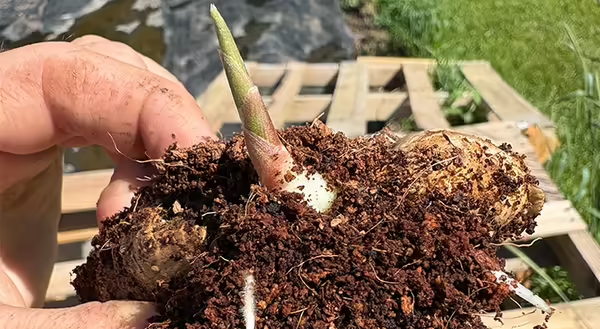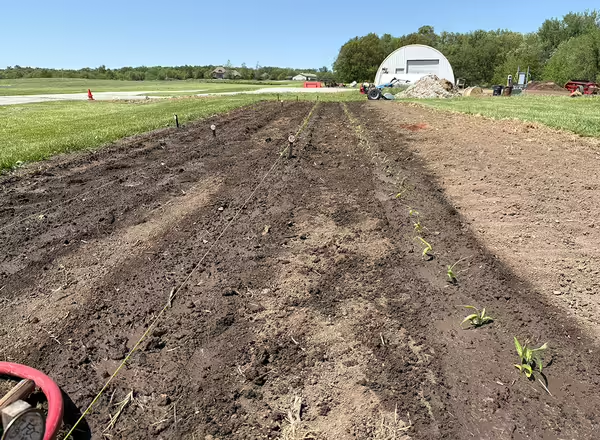
After about 4.5 weeks of pre-sprouting in coconut coir, using heat mats, temperature controllers set to 77 F, and humidity domes, 8x 1020 flats of ginger rhizomes were ready for planting on May 16th. Additionally, one flat of tissue-culture ginger plants received on May 9th were ready as well.
Site 1 – Unity Community Center Food Production and Demo Garden – Normal, IL
We already know that ginger can be grown in open field conditions in southern Illinois, because of the fantastic crop production work done by Pink Tiger Farms staff in Goreville, IL over the last two seasons. We also know that it can be grown in central Illinois, in-ground, under the protection of 30% shade cloth, because that’s how it was grown at our site last year, with satisfactory results.
This year, we will grow our ginger at the Unity Community Center in canvas grow bags, outdoors, with no shade protection, to better understand the wide variety of potential ginger cultivation options for Illinois specialty crop growers. In this case, cultivation of ginger in large grow bags could be especially attractive to urban growers in metro areas of our state that have limited access to in-ground cultivation options.
Previous work has been done to understand the effects of container volume and planting density on the growth and yield of ginger and turmeric, most notably a research paper by Retana-Cordero at al. 2022 – “Effects of Container Volume and Planting Density on Ginger and Turmeric Growth and Yield.” Our grow bag trial seeks to add to this body of knowledge, especially in terms of levels of fertility needed for optimum container-grown ginger production.
In this trial, we have 24 total grow bags - 12 grow bags of two sizes, 5-gallon or 10-gallon. We have three fertility levels. Bags 1-8 growing media consists of General All-Purpose Pro-Mix with low nutrient charge, which will serve as our control. Bags 9-16 growing media consists of the Pro-Mix product plus a high-quality plant-based compost amendment of about 25% of total bag volume, and Bags 17-24 growing media consists of Pro-Mix, compost, and will get fertigation with Cal-Mag 17-4-17 every 3 days as needed. 5-gallon bags also received ½ cup of Sustane-Naturally starter fertilizer, while 10-gallon bags received 1 cup of the same product.
Prior to planting, our bags were filled with their respective materials, all bags were mixed thoroughly, and pre-sprouted ginger rhizome was then planted at a density of three rhizomes to a bag, about 4-6” apart in bags. Two rhizomes of VNS (Variety Not Stated) yellow ginger from the Farm on Central were planted per bag, while one ‘Buffalo Gung’ rhizome from Hawaiian Organic Ginger was planted, per bag, for a total of three rhizomes per bag.
This grow bag trial is being replicated in Cook County this year by Extension Educator Zack Grant, and we both plan to repeat this experiment next year. We hope to publish our findings.
The thesis of this experiment is that the ginger grow bags with the most fertility added should yield more marketable fresh-weight ginger rhizome than the moderate fertility treatments, which should themselves yield more than the low-fertility treatments. Ginger rhizome is a heavy feeder crop and can underperform, in terms of marketable rhizome development, in the absence of sufficient fertility.
Site 2 - Epiphany Farms Estate – Downs, IL
Later that same day, pre-sprouted ginger rhizomes were taken to Epiphany Farms Estate in Downs, IL, for planting in outdoor open-field conditions. Epiphany Farms Estate agreed to host an outdoor ginger rhizome variety trial this year so that they can learn first-hand about the potential for high-quality, field-grown ginger production in Central Illinois. This also does Extension a huge favor by providing us with a real-world farm business property where we can trial our best understanding of crop production, with their tools, tractors, methods, fertility practices, irrigation systems and more.
Production beds at Epiphany Farms were worked twice with a power-harrow attachment of the farm’s BCS two-wheel tractor, about 24 hours apart, 1 day before planting, and the second time immediately before planting. Ginger was planted 30” apart between row, on 45” bed tops. Spacing within-row was 12” for pre-sprouted rhizomes, and about 6-8” within row for tissue-culture ginger plants.
Four varieties of ginger were planted.
- ‘Buffalo Gung’ – rhizome – Hawaiian Organic Ginger (HI)
- ‘Bird’ – rhizome – Hawaiian Organic Ginger (HI)
- VNS (variety not stated) yellow – rhizome – the Farm on Central (OH)
- VNS (variety not stated) white – tissue-culture plant – Agristarts (FL)
In previous years, Extension Educators and small farmers alike have decided whether to plant their pre-sprouted ginger rhizomes in 6-8” deep trenches. Trench-planting ginger rhizome has been generally recommended by currently accessible ginger production guides and is also how we planted our ginger rhizomes at the Unity Community Center Production and Demo Garden the last two years, with mixed results.
At the Epiphany Farms Estate planting site, it was instead decided to transplant 85% of rhizomes as if they were a kale or cabbage transplant – by burying sprouted rhizomes only a few inches under soil surface. This is in line with planting methodology used by our most successful producer farm in southern Illinois – Pink Tiger Farm. The remaining 15% of rhizomes were planted as in years past, in trenches dug about 6-8” deep and wide, as is common for potato seed planting. It will be great to compare the performance of these two planting strategies (to trench or not to trench) over the course of the season, in-situ.
Immediately after planting, the rhizomes were watered in. Notably, cool, wet, cloudy conditions have replaced warm, sunny, dry conditions in the last 24 hours, and are projected to persist for several days – right in time for the planting of a crop that enjoys sub-tropical to tropical temperatures. Although the watering-in is ideal, we hope for warmer temperatures again soon.
